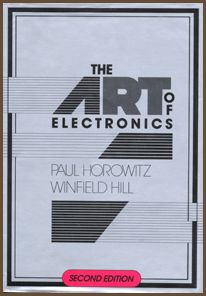
The Art of Electronics 2/e
by Paul Horowitz and Winfield Hill
Cambridge University Press, 1989
1125 pages, hardcover
ISBN 0-521-37095-7
$55.79 at Amazon.com (click to purchase)
Book reviewed 2004.07.24
This book is positively wonderful. Go buy it.
Hmmmm, not much of a review is it? Well, I'm just going to end up making the same point with more verbosity, but here goes...
This book covers everything from basic electronics (resistors, capacitors, inductors, transistors...) to advanced topics like low-noise, high-power, and RF design. It is written engagingly enough for the hobbyist, yet even practicing electrical engineers can learn something from it.
Why is it so engaging? Partly it's the easy-going writing style. Partly it's the rare but tasty laugh-out-loud zingers. Partly it's the minimal mathematics. Partly it's the fact that each chapter builds up understanding a piece at a time starting from useful basics. And partly it's the 1500+ illustrations. (More than one per page!) This book is deep, subtle and broad.
I want to talk more about "deep". This book doesn't just explain the practical physics of electronics. It gives real circuits, not just toy circuits. Frequently the authors use a really useful construct almost in passing, even when a simpler circuit might also serve their purpose. The circuits aren't needlessly complex, they are elegantly powerful. You will find yourself dipping back into the book for circuit ideas to solve real problems. Few introductory electronics books are useful beyond the first reading.
I also want to talk about "subtle". Frequently it has taken me many minutes to get through a single page of the text. I don't believe it is because I am slow. No, it is simply that the text is absolutely packed with details; it is information-rich. One could read through it quickly and get a good understanding, but the book rewards careful study.
This book is beautifully designed. The typesetting is clean, the schematics are perfect examplars of the art, and some of the charts and tables could have come from an Edward Tufte book. The book's popularity and longevity probably explain why I haven't yet found any errors, whether in grammar, spelling or fact.
This book is 15 years old as I write this, but most of it is still quite relevant. Analog electronics really hasn't come very far since the book was published: just the other day I designed a new circuit using an IC designed over 30 years ago. Neither has our understanding of physics changed in any way relevant to this book's scope: the Laws of Ohm and Kirchoff still apply to our circuits.
The only part that really shows its age are the digital chapters, and that mainly by omission: the book obviously doesn't cover recent technologies. Most of what it does cover is still relevant: you can still buy most of the parts mentioned, and even obsolete ones can teach you about their successors. Consider this: the first part of chapter 11 covers the Motorola 68008 microprocessor, which you can no longer buy, but you can buy a compatible modern variant from Digi-Key right now for less than the cost of some popular premium op-amps.
The Bottom Line
This book will not teach you how to interface an MPEG decoder ASIC to an ARM9 microcontroller, but what it does teach still matters. In its niche, it has yet to be bettered. No wonder it's still in print after 15 years.
This book costs a lot, but I think you'll find it useful a lot farther into the future than any other beginning electronics book. If you continue using electronics for any length of time, it will pay for itself better than a cheaper book.
Related Resources
The authors have a web site for the book. Most of the site is just promotional material, but there are a few neat things there. Cambridge University Press also has a page dedicated to this book.
There is a student manual for the book. On casually flipping through it, it seems useful mainly in a teaching setting; the book has little explanatory text. It's more of a book of exercises than anything else.
You can get more reader reviews at the Amazon.com and Cambridge University Press links above.